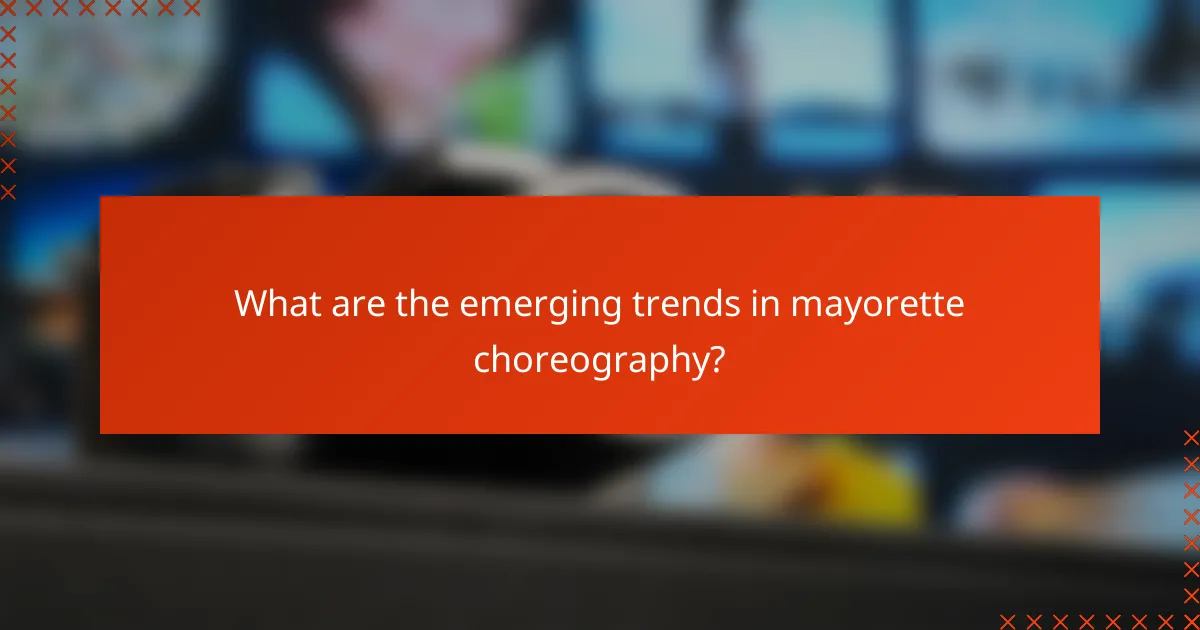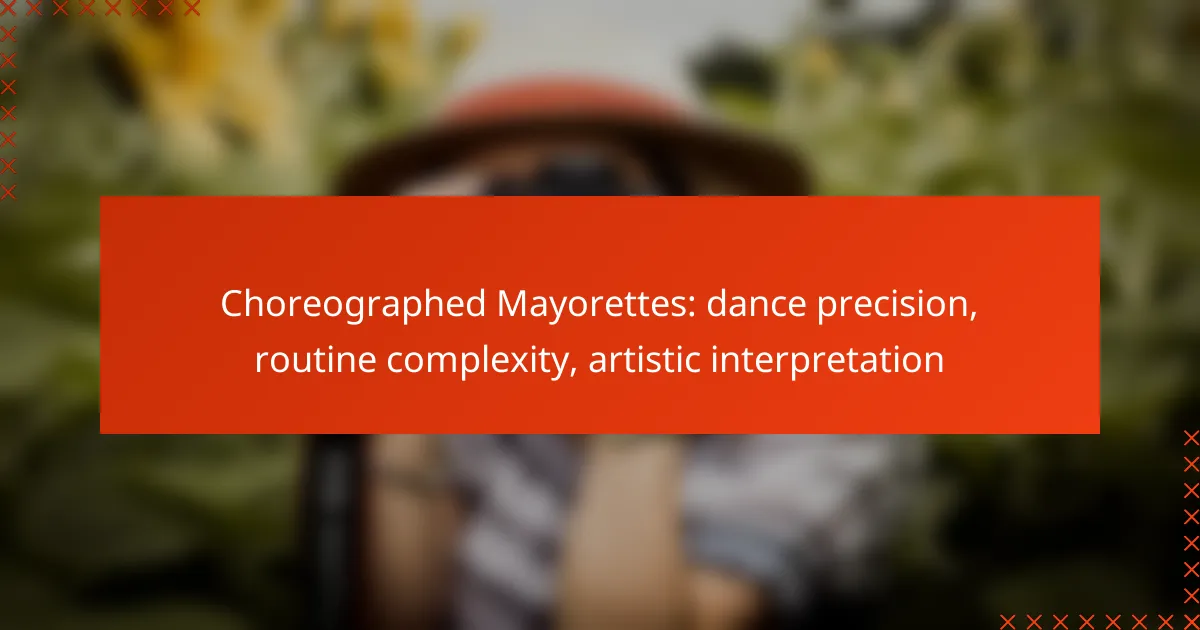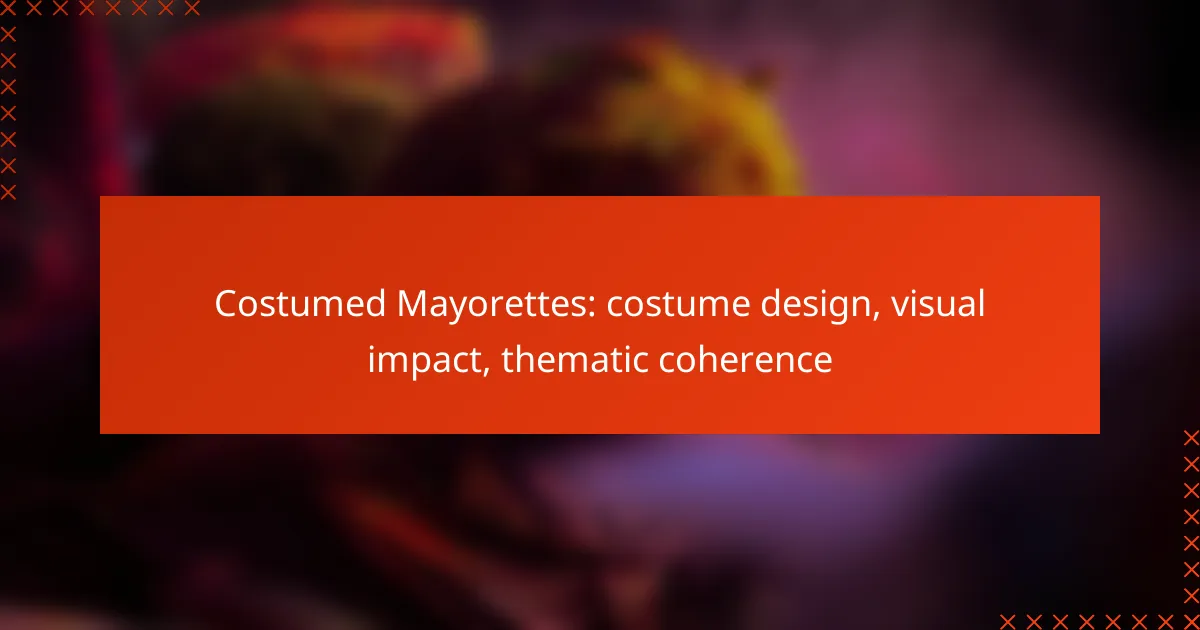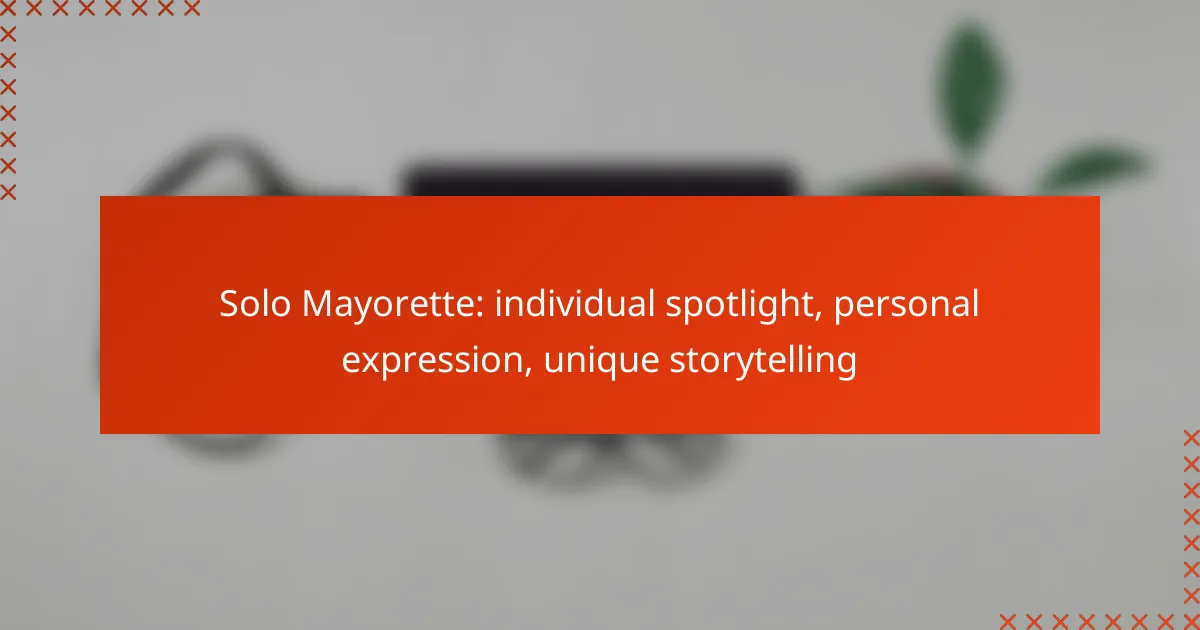Choreographed mayorettes exemplify dance precision through meticulously crafted routines that prioritize coordination and uniformity. The complexity of their performances is highlighted by intricate choreography, requiring synchronization and accuracy, while artistic interpretation adds depth through storytelling and visual elements. Together, these components create captivating displays that engage and inspire audiences.

How do choreographed mayorettes enhance dance precision?
Choreographed mayorettes enhance dance precision through meticulously planned routines that emphasize coordination and uniformity. Their performances rely on structured formations, synchronization techniques, and footwork accuracy to create visually striking displays that captivate audiences.
Structured formations
Structured formations are essential for mayorettes, as they define the visual impact of the performance. These formations often include lines, circles, and geometric shapes that require dancers to maintain specific positions relative to one another. A well-executed formation can enhance the overall aesthetic and highlight the dancers’ skills.
To achieve effective formations, mayorettes practice transitioning smoothly between different shapes. This involves understanding spacing and alignment, ensuring that each dancer knows their role within the group. Regular rehearsals help solidify these formations, allowing for quick adjustments during performances.
Synchronization techniques
Synchronization techniques are crucial for mayorettes to ensure that all dancers move in unison. This precision is achieved through counting beats, visual cues, and sometimes even auditory signals, allowing the group to execute complex movements together. Effective synchronization enhances the overall impact of the performance.
To improve synchronization, mayorettes often practice with mirrors or video recordings to identify areas for improvement. Additionally, using a metronome during rehearsals can help dancers stay in time with the music, fostering a cohesive performance that captivates the audience.
Footwork accuracy
Footwork accuracy is a fundamental aspect of mayorette performances, as it directly influences the precision of movements. Dancers must master various steps, turns, and transitions to maintain rhythm and alignment with their peers. Accurate footwork not only enhances the visual appeal but also ensures safety during performances.
To achieve footwork accuracy, mayorettes should focus on technique and practice regularly. Breaking down complex sequences into manageable parts can help dancers master each movement before combining them into a full routine. Consistent practice and attention to detail are key to perfecting footwork and enhancing overall performance quality.

What is the complexity of mayorette routines?
The complexity of mayorette routines lies in their intricate choreography, which requires precision and synchronization among performers. These routines often combine various elements, including tempo changes and the use of props, to create a visually captivating performance.
Layered choreography
Layered choreography involves multiple dance elements that performers execute simultaneously, creating a rich visual tapestry. This complexity requires dancers to master their individual movements while staying in sync with the group, often necessitating extensive practice sessions.
For example, a routine may feature a base layer of marching combined with upper body movements and intricate footwork. This layering enhances the overall aesthetic and demands high levels of coordination and timing.
Varied tempo changes
Varied tempo changes add dynamic interest to mayorette routines, shifting the pace to evoke different emotions or highlight specific moments. Dancers must be adept at adjusting their movements to match these tempo shifts, which can range from slow, graceful motions to fast, energetic sequences.
Incorporating tempo changes can also emphasize key transitions in the music, allowing performers to showcase their skills and maintain audience engagement. Practicing these shifts is crucial to ensure seamless execution during performances.
Integration of props
The integration of props, such as batons, flags, or ribbons, enhances the visual appeal of mayorette routines and adds another layer of complexity. Proper handling and coordination with props require additional practice and focus, as dancers must ensure their movements are synchronized with the prop’s motion.
For instance, using batons in a routine can create striking visual effects, but it also demands precision in timing and control. Dancers should start with basic prop techniques before incorporating them into more complex routines to build confidence and skill.

How is artistic interpretation expressed in mayorette performances?
Artistic interpretation in mayorette performances is conveyed through a combination of emotional storytelling, costume design, and musical selection. Each element works together to create a cohesive narrative that captivates the audience and showcases the dancers’ skills.
Emotional storytelling
Emotional storytelling in mayorette performances involves conveying feelings and themes through movement and expression. Dancers often embody characters or narratives, using their choreography to reflect emotions such as joy, struggle, or triumph.
To enhance storytelling, mayorettes may incorporate gestures, facial expressions, and formations that align with the chosen theme. For example, a routine depicting a historical event might include movements that symbolize conflict and resolution, engaging the audience on a deeper level.
Costume design choices
Costume design plays a crucial role in artistic interpretation by visually representing the theme of the performance. Bright colors, intricate patterns, and culturally significant elements can enhance the overall aesthetic and emotional impact.
When selecting costumes, mayorettes should consider how the attire complements the choreography and reflects the intended narrative. For instance, a routine celebrating a local festival might feature traditional garments that resonate with the audience, reinforcing cultural pride.
Musical selection
The choice of music significantly influences the artistic interpretation of a mayorette performance. The rhythm, tempo, and mood of the music should align with the choreography to create a seamless connection between sound and movement.
Mayorettes often select music that enhances the emotional storytelling aspect, whether it be upbeat tunes for celebratory themes or slower melodies for reflective narratives. A well-chosen soundtrack can elevate the performance, making it more memorable for the audience.

What are the benefits of mayorette performances in Canadian culture?
Mayorette performances offer numerous benefits to Canadian culture, including fostering community spirit, enhancing local events, and encouraging youth involvement in the arts. These performances blend precision dance with artistic expression, creating a vibrant cultural experience that resonates with audiences.
Community engagement
Mayorette performances play a crucial role in community engagement by bringing people together through shared experiences. Local festivals and parades often feature mayorette teams, allowing residents to connect with one another and celebrate their cultural heritage. This participation fosters a sense of belonging and pride within the community.
Moreover, these performances can serve as a platform for local artists and performers, encouraging collaboration and interaction among diverse groups. Engaging in mayorette activities can strengthen community ties and promote inclusivity across different age groups and backgrounds.
Promotion of local events
Mayorette performances are effective in promoting local events, drawing attention and attendance to festivals, parades, and other gatherings. Their visually captivating routines attract audiences, making events more appealing and lively. This increased foot traffic can benefit local businesses and create a festive atmosphere.
Additionally, mayorette teams often participate in promotional activities leading up to events, such as community workshops or demonstrations. These initiatives help raise awareness and generate excitement, ensuring that local events receive the attention they deserve.
Youth participation
Mayorette performances encourage youth participation by providing opportunities for young individuals to engage in dance and performance arts. Many mayorette teams are composed primarily of youth, allowing them to develop skills such as teamwork, discipline, and creativity. This involvement can lead to personal growth and a lifelong appreciation for the arts.
Furthermore, participating in mayorette teams can enhance social skills and build confidence among youth. As they perform in front of audiences, they learn to overcome stage fright and express themselves artistically, which can have lasting positive effects on their overall development.

What criteria should be considered for selecting mayorette teams?
When selecting mayorette teams, it’s essential to consider experience level, team cohesion, and performance history. These criteria help ensure that the team can deliver precise and complex routines while maintaining artistic interpretation.
Experience level
The experience level of mayorette team members significantly influences their performance quality. Teams with members who have prior experience in dance or similar activities tend to execute routines with greater precision and confidence. Look for teams that have participated in competitions or have trained under qualified instructors.
Consider the range of experience within the team. A mix of seasoned performers and newcomers can foster mentorship and growth, enhancing overall team dynamics. However, ensure that the majority of the team possesses a solid foundation in dance techniques.
Team cohesion
Team cohesion is critical for mayorette teams, as synchronized movements and unified artistic expression are essential for captivating performances. A cohesive team communicates effectively, supports one another, and shares a common vision for their routines. Assess how well team members interact during rehearsals and performances.
To evaluate cohesion, observe practice sessions and look for signs of collaboration and mutual respect. Teams that engage in team-building activities often develop stronger bonds, which can translate into improved performance quality.
Performance history
A team’s performance history provides valuable insights into their capabilities and consistency. Review past performances, competition results, and feedback from judges to gauge their strengths and weaknesses. Teams with a history of successful performances are likely to maintain high standards in future routines.
Consider the types of events the team has participated in, as well as their adaptability to different performance settings. A diverse performance history can indicate a team’s ability to handle various challenges and showcase their artistic interpretation effectively.

What are the emerging trends in mayorette choreography?
Emerging trends in mayorette choreography focus on blending traditional routines with modern influences, enhancing both performance quality and audience engagement. Choreographers are increasingly incorporating contemporary dance styles and utilizing technology to create captivating displays that resonate with diverse audiences.
Incorporation of contemporary dance styles
Mayorette choreography is evolving to include contemporary dance styles such as hip-hop, jazz, and even ballet. This fusion not only adds complexity to routines but also appeals to younger audiences who appreciate modern dance forms. For example, integrating breakdancing elements can energize a performance and showcase the dancers’ versatility.
When incorporating these styles, choreographers should consider the skill levels of the dancers and the overall theme of the performance. Balancing traditional mayorette movements with contemporary techniques can create a unique aesthetic while maintaining the essence of mayorette dance.
Use of technology in performances
Technology is playing a significant role in enhancing mayorette performances through the use of lighting, sound, and digital effects. Many teams are now using LED costumes and projection mapping to create visually stunning backdrops that complement their routines. This integration of technology can elevate the audience’s experience and make performances more memorable.
Choreographers should be mindful of the technical aspects when planning routines. Ensuring that dancers are comfortable with any technological elements is crucial to avoid distractions during performances. Additionally, rehearsing with the technology in place can help identify any potential issues before the actual event.



